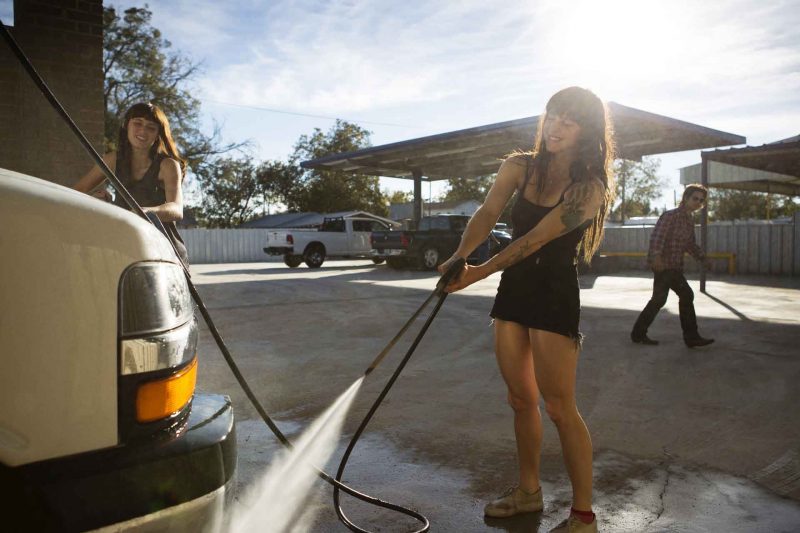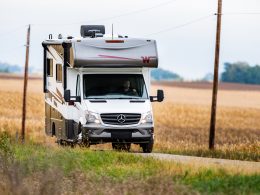They say the only certain things in life are death and taxes. However, if you’re an RV owner, you can add RV maintenance to that list, too.
Whether you buy a pop-up camper or a massive rig that costs six figures, you’ll need to maintain it from time to time. Doing so will help extend the life of your rig and ensure it’s ready for whatever adventures you have planned.
Today, we’re sharing several RV maintenance items you probably didn’t know you should be doing. Let’s have a look at what you might have been missing all these years.

What Is Typical RV Maintenance?
All RVs need regular maintenance to extend their life and to help them avoid sitting in the repair shop. Walk around your rig regularly and visually inspect it, including the roof.
Also, regularly wipe down moving parts to help avoid dirt and debris from building up. Some of the most common moving parts are the leveling and stabilizer jacks or the gears and supports on your slides.
A critical piece of RV maintenance is getting on the roof and inspecting it. Look for any signs of potential issues. Rips, tears, or weak spots in the roof are major problems you’ll want to address immediately.
While on the roof, you’ll also need to inspect the seals around your vents, skylights, and the edges of your RV. Look for any cracks or pealing from the sealant.
In addition to walking around and climbing on the roof of your rig, you’ll want to crawl under it. Check your tires and suspension system for any potential issues that could be lurking. The more you inspect your RV, the easier it will be to notice even small changes that could be signs of a major issue.
You can’t forget to maintain your holding tanks and plumbing system. This includes cleaning and sanitizing them regularly. If you’re using your rig for full-time traveling, you’ll want to do this every two or three months. However, if you’re using your rig seasonally, you can make this a part of your annual maintenance list at the beginning and end of each camping season.
HOT TIP
We know, RV maintenance can be a lot to keep track of. Make it a little easier with our Spring RV Maintenance Checklist.
What Are the Most Common RV Repairs?
Some of the most common RV repairs are roof and plumbing leaks, faulty electrical appliances, and accidental damages. Accidental damage could be from hitting something while maneuvering your RV or a blown tire.
A blown tire can cause thousands of dollars in damage to an RV and be a dire situation. This is why you should check your tire pressure and look for any potential issues with your tires.
Keeping up on your maintenance can help you identify any changes resulting from any repairs you might need to complete on your RV. Luckily, some of the most common RV repairs are relatively easy, and just about anyone can complete them.

RV Maintenance You Probably Didn’t Know You Should Be Doing
There are some RV maintenance items that you should be doing regularly. And unless you have a wad of cash burning a hole in your pocket, you won’t always want to pay a professional to do it. If possible, learn to do them yourself and save your money for your future RV adventures.
Checking Seals
You’re going to find seals all around your RV. The purpose of these seals is to prevent water from infiltrating your RV.
You’ll find them around windows, slides, and all over your roof and sides of your RV. The sealant on the roof is typically white. On the sides, it’s usually clear.
You want to investigate every inch of the seals around your RV carefully. Look for any signs of cracking, peeling, or other damage that could be an issue. The sealant will crack and peel as it dries out from extended exposure to the sun.
Keep both types of sealants on hand and inspect your seals every 30 to 60 days. You could risk voiding a warranty if you do not maintain these regularly. Check the requirements from your manufacturer to avoid making any mistakes that could cost you your RV’s warranty.
HOT TIP
Find out if you’re at risk for accidentally voiding your RV warranty.
Air Conditioner Maintenance
The air conditioner on your RV is one thing you want to be as efficient as possible. Keeping up on your air conditioner’s maintenance can help keep your rig cool and ensure that your A/C unit lasts as long as possible.
Keep the coils and filters as clean as possible and make this a part of your annual maintenance before the start of each camping season. If you’re full-timing in your RV, you’ll want to do this more frequently, depending on how much you run your air conditioner.
Our friends at the National RV Training Academy created a quick and easy-to-follow video (above) to help explain the importance of air conditioner maintenance and how to do it. Todd’s tips show that this is one maintenance task that just about anyone can do, as long as they can access the roof of their RV.
Sanitizing Fresh Water Holding Tank
Keeping your RV’s fresh water holding tank sanitized is essential. If not, you could create an ideal breeding environment for dangerous molds and other bacteria to grow in your tank.
You should completely sanitize your fresh water system every three to six months. If you only use your RV seasonally, you can make this one of the items you do at the start and end of every camping season.
Sanitizing your freshwater holding tank will require a tremendous amount of water. It’s best to book a full hook-up campsite so that you can access water and sewer connections.
First, you need to know the size of your freshwater tank. Pump a cup of water for every 50 gallons into your holding tank. The best way to do this is to dump the proper amount of bleach into your water hose and then immediately connect your water hose to the available water connection.
Adjust your RV’s water settings to bypass your RV’s water heater, which the bleach could damage. Check the documentation on your rig for how you’ll need to adjust the settings on your water system to bypass it. Once you bypass the water heater, turn on the water connection and fill your holding tank.
The Sanitation
With a full fresh water tank, run water through every RV’s toilet, showerhead, and faucet until you smell the bleach. Don’t forget outside showers and faucets during this process.
You’ll then need to let the mixture sit in your plumbing system for 8 to 12 hours. You won’t have access to any water in your RV during this time. So if you plan to stay in your RV during this time, you’ll want to consider letting it sit overnight and finish in the morning.
Once the mixture has had time to sit in your freshwater holding tank and the rest of your water system, you’ll need to run your water to cycle through all the water in the tank. This will remove the bleach-water mixture from your holding tank.
Once you cycle through the water, you’ll want to fill up your tank with clean water and run all of the faucets, toilets, and showerheads until the bleach smell is gone.
This can be a long and tedious process, but it’s required. Chad and Tara of Changing Lanes did an excellent job walking viewers through the entire process. Check out their video below to learn how to do it yourself!
This can be an intimidating maintenance project for the first time, but it’s one that just about anybody can do as long as they take their time.
Washing and Waxing Exterior
You’ve already spent all that money on your RV, why not keep it looking good? Washing and waxing the exterior of your RV is a project you should be doing regularly. Cleaning off the bugs and other gunk you’ve picked up along the way during your adventures can help your rig look new for years.
You’ll need similar items you’d use to wash your car. However, some RVs can be 13 feet tall, so you will also need a ladder. Get a safe detergent, sponge, and rags to scrub away any debris on your RV.
Most campgrounds and RV parks won’t allow owners to wash their rigs at campsites. It uses a tremendous amount of water and can cause flooding, affecting other campers and their water bill.
One option for keeping your RV clean is to use a truck wash, which also serves as an RV wash. You’ll find these at truck stops and other convenient locations. They typically charge based on the size or type of rig and are very cost-effective. You want to tell them not to use the brushes on your rig, which could scratch or damage the finish on your RV.
Cleaning Vents Regularly
You want to keep your air conditioning vents clean, especially if you frequently use your air conditioner. To do so, remove the filters behind the vents and wash away the dust or replace them as needed.
During the peak camping season, checking your vents before every trip can be a good idea. This helps ensure you’re getting the most efficient use of your RV and setting it up for success while keeping you and your RV cool while you’re using it.

Cleaning and Lubricating Slide-Outs
The slide-outs on your RV maximize the usable space inside your rig. However, you want to clean and lubricate them regularly to help them go in and out smoothly every time.
With your slides extended, climb under your rig and wipe down the slides and supports for the slide box. Clean of any dirt and debris that’s found its way onto them.
You’ll then want to spray a slide lubricant along the supports and the various gears that allow the slide-out to move in and out. Have a second person close the slide and spray the moving parts a few times with the lubricant. You can open and close it again to ensure the lubricant gets applied evenly to all the moving parts.
Keeping Locks Clean
The locks on your RV help ensure that you and the stuff inside your RV are safe. Since they sit outside exposed to the elements for most of their life, they can get dirty and weathered.
Spraying a dry lube inside the lock can help expel the moisture and dirt inside your locks. You’ll likely notice the locks are easier to use after cleaning them. Just ensure you do all the locks on storage compartments around your rig.
How Often Do RVs Break Down?
It’s not uncommon for RVs to experience mechanical issues. However, complete breakdowns aren’t nearly as common, especially in towable RVs.
Those in motorhomes and other drivable RVs are more likely to experience a breakdown as they have more complex systems. The more complex a system, the more likely the possibility of something going wrong — leading to a breakdown.
You can minimize the chances of experiencing an RV breakdown by keeping up on the maintenance of your rig. It will most likely take care of you if you take care of it. So don’t neglect your RV’s maintenance no matter what type of RV you have.

What Is the Average Lifespan of an RV?
A typical RV has a lifespan of 10 to 20 years, depending on how well you maintain it.
Some RVs, like Airstreams, have a reputation for lasting 30 to 50 years. They may require maintenance and attention from time to time, but you can have decades of adventures in your RV if you take care of it.
Can Regular Maintenance Prolong the Life of Your RV?
Doing regular maintenance on your RV can prolong its life. This is because you’re more likely to catch any minor issues before they worsen and become major problems.
The more you familiarize yourself with your RV, you’ll be able to recognize small changes that could be the first indications of an issue.
Make sure you follow the recommended maintenance schedule for your rig and all its appliances and systems. This can help you enjoy your RV for years while having smoother adventures.










